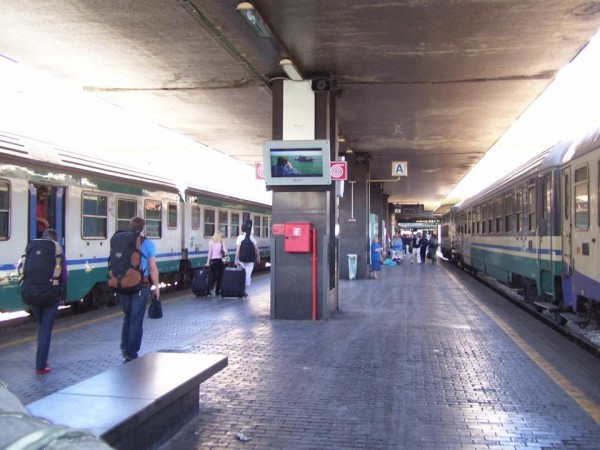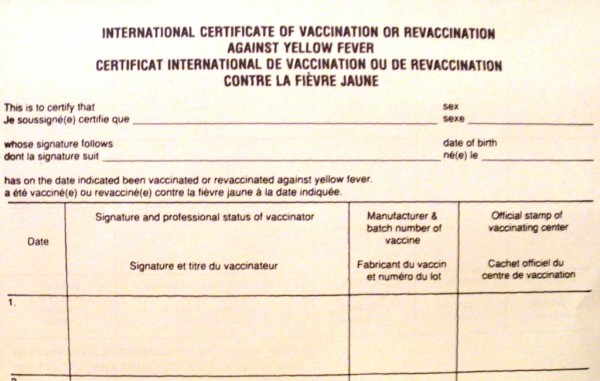Over the last few weeks, we’ve recapped some of the best posts about preparing to take a career break to travel from 2012, as well as the best from career breakers on the road. Today, we look back at some of the most valuable “how to” posts – practical advice that you can use before, during or after your career break!
How to Stay in Shape on the Road
 Five years out of college, Matt Sussman could no longer ignore his constant itch to travel. Leaving his stressful financial job in New York behind, he is following his dream of traveling the world. Meandering solo since July, Matt has made it a priority to find time to exercise and shared his tips for staying in shape on the road.
Five years out of college, Matt Sussman could no longer ignore his constant itch to travel. Leaving his stressful financial job in New York behind, he is following his dream of traveling the world. Meandering solo since July, Matt has made it a priority to find time to exercise and shared his tips for staying in shape on the road.
As I started planning my career break, I struggled with how I would manage to stay in shape on the road without a gym to go to every day. I had been looking for a theme to keep me sane in my travels and thought what better challenge to keep me motivated than trying to stay in shape while traveling around the world?
Searching online for how other travelers dealt with this dilemma yielded little useful advice. Sure I could just run every day but that would quickly get boring, not too mention the pounding my knees would take. Pulling what I could from crossfit sites and conversations with trainers, I started to assemble a word document of body weight exercises and routines that I could do on the road. Continue…
How to Land a Crewing Job at Sea
 Kelly Wetherington has been traveling since she first escaped her cubicle in 2007. Her insatiable curiosity for the world and thirst for adventure have led her to trek, dive, sail, zip, surf, climb, and paddle her way through 25 countries across Central America, Europe, Southeast Asia, and the Pacific. In this post, she shared her tips for finding a crewing job at sea.
Kelly Wetherington has been traveling since she first escaped her cubicle in 2007. Her insatiable curiosity for the world and thirst for adventure have led her to trek, dive, sail, zip, surf, climb, and paddle her way through 25 countries across Central America, Europe, Southeast Asia, and the Pacific. In this post, she shared her tips for finding a crewing job at sea.
Learn as much as you can before you seek a position.
Go sailing, practice tying knots, familiarize yourself with yachtie terms.
Learning to sail is like learning to speak a foreign language. If you aren’t willing to ask the dumb questions like “What does to reef mean?” then you will never learn the lingo (reefing is taking in a sail). Continue…
How to Account for a Career Break on Your Resume
One of the most common questions we get about re-entry is “how do I explain my career break on my resume?” This post offered some valuable tips and examples.
You arrive home at the end of a life-changing travel experience and one of the biggest questions facing you likely will be how to find work again. Whether you traveled as part of a career break, gap year, or sabbatical, you will need to figure out how to best represent the time and experiences on your resume.
Where should it go on my resume?
It depends. Do you think the experiences you had traveling apply to you finding a new job in your field? If so, then place it in the main part of your resume. If you don’t feel like it applies, then it probably belongs in a section reserved for Additional Information or Hobbies. Continue…
How to Make Career-Related Connections on the Road
 Bethany Rydmark is a landscape architect by trade and a lover of the world by nature. She and her husband Ted left their beloved home state of Oregon in 2012 to travel South America, the Mediterranean, the Middle East, Africa, Southeast Asia, and New Zealand. She made a point to make career-related connections before she hit the road and shared this advice.
Bethany Rydmark is a landscape architect by trade and a lover of the world by nature. She and her husband Ted left their beloved home state of Oregon in 2012 to travel South America, the Mediterranean, the Middle East, Africa, Southeast Asia, and New Zealand. She made a point to make career-related connections before she hit the road and shared this advice.
Though I left my job behind to travel the world for thirteen months, I did not abandon my career.
Intentional preparation allowed me to harness my professional skills, expand my experience and qualifications as a landscape architect, and add value to my travels. By laying groundwork before departure and remaining engaged on the road, I’ve connected with relevant projects and opportunities, and as a bonus, I’ve leveraged my skills to offset traveling expenses. While my story is connected to landscape architecture, the concepts apply to careers across the spectrum: nursing, construction, sales, finance, writing, painting, teaching…you name it!
As you plan your career break, consider these eight tips for making career-related connections on the road. Continue…
How to Make Processing Part of the Re-Entry Process
 Cate Brubaker helps all kinds of travelers navigate intercultural, personal, and re-entry experiences in her work with TrekDek, SmallPlanetStudio.com, and the University of North Carolina-Chapel Hill.
Cate Brubaker helps all kinds of travelers navigate intercultural, personal, and re-entry experiences in her work with TrekDek, SmallPlanetStudio.com, and the University of North Carolina-Chapel Hill.
You’re probably familiar with the terms re-entry and reverse culture shock. While some people sail through re-entry problem-free, most say they feel more lost upon returning home than they ever did abroad. This actually makes a lot of sense. When we go abroad we’re constantly in the “new.” We’re seeing new things, having new adventures, hearing new languages, trying new food, considering new perspectives.
It’s exhilarating. Euphoric. It’s why we travel!
Back home, we’re no longer in the “new.” Back home, we are the new. On one hand, we’re happy to be home with family and friends, speaking our native language, eating our favorite foods, and even sleeping in our own bed. But we also feel like something is a bit off. It’s not necessarily bad, just…off. Continue…
How to Accrue Frequent Flier Miles
 Mike Choi is known as the resident world traveler in his office and blogs about his travels at thefitworldtraveler.com. With his knowledge of FFM, he runs a part time frequent flyer mile consulting shop at iflywithmiles.com to help those with miles see the world. He provided a great two-part series earlier this year about how to accrue and redeem frequent flier miles. Here is an excerpt from part one:
Mike Choi is known as the resident world traveler in his office and blogs about his travels at thefitworldtraveler.com. With his knowledge of FFM, he runs a part time frequent flyer mile consulting shop at iflywithmiles.com to help those with miles see the world. He provided a great two-part series earlier this year about how to accrue and redeem frequent flier miles. Here is an excerpt from part one:
Frequent Flyer Miles (FFM) can be an excellent way to subsidize airfare costs during your career break. For those unfamiliar with FFM, they are a unit of rewards earned through an airline’s loyalty program by flying. The objective of these loyalty programs is to retain customers by rewarding customers with miles, which translate to free flights with enough accumulated miles.
In the United States, aside from flying, there are numerous ways to earn FFM such as purchases with co-branded airline cards and a slew of other promotional offers. Unless you have a lot of reimbursable expenses, purchases with a co-branded airline credit card will not generate enough miles for a flight in a timely manner. This post will focus on flying, assuming there are some future career breakers who travel for work and are allowed to accumulate FFM for personal use. Continue…
How to Redeem Frequent Flier Miles
The second part of Mike’s series on frequent flier miles focused on how to redeem those valuable miles.
As discussed in Monday’s post, How to Accrue Frequent Flier Miles, earning and redeeming miles can be a great way to save money on your career break.
All frequent flyer mile (FFM) programs publish an awards table for the required miles needed for a flight redemption. The exact number, of course, depends on your origin and destination countries. For instance, at the time of this writing, U.S. Airways, a Star Alliance member, requires 60,000 miles to fly round trip from North America to North Asia while United Airlines, another Star Alliance airline, requires 65,000 miles for the same round trip flight. Continue…
 Jannell Howell recently returned from an around-the-world journey that took her through many countries including Thailand, India, Jordan, and Europe. Before she left, she discovered a love of researching travel-related gear and services and shared some of her favorite finds with us.
Jannell Howell recently returned from an around-the-world journey that took her through many countries including Thailand, India, Jordan, and Europe. Before she left, she discovered a love of researching travel-related gear and services and shared some of her favorite finds with us. Mike Watkins and Akiko Kubo decided to “cash-in” on their dreams of taking a career break to travel around the globe after seeing close friends’ and family’s lives end too soon. They wrote this guest post to share what they learned after spending countless hours figuring out what travel immunizations they needed prior to their trip.
Mike Watkins and Akiko Kubo decided to “cash-in” on their dreams of taking a career break to travel around the globe after seeing close friends’ and family’s lives end too soon. They wrote this guest post to share what they learned after spending countless hours figuring out what travel immunizations they needed prior to their trip. Sarah Schauer began her career break in June 2012 with a domestic seasonal opportunity before heading to Europe, Africa, South America, and New Zealand. She put together a great list of resources to use when you start planning your own career break.
Sarah Schauer began her career break in June 2012 with a domestic seasonal opportunity before heading to Europe, Africa, South America, and New Zealand. She put together a great list of resources to use when you start planning your own career break. Mike Shubbuck and his better half, Tara, left on a round-the-world trip on June 6, 2012. He wrote this guest post comparing making the leap to travel the world to jumping out of an airplane.
Mike Shubbuck and his better half, Tara, left on a round-the-world trip on June 6, 2012. He wrote this guest post comparing making the leap to travel the world to jumping out of an airplane.


 If you have student loans or other financial commitments that you need to meet while living abroad; or if you just want to save money for additional extended travel, consider teaching in an Asian or Middle Eastern country, where most English teachers typically make enough to save 30%-50% of their income after expenses. Schools in some of these nations will even provide you with free housing and fund your airfare. In countries like Vietnam or Taiwan, that means saving up to $6,000 after a year of teaching, or in South Korea, you can save $10,000 – $15,000 a year. With those savings, you can fund months of travel virtually anywhere in the world, and you’ll do it while living in the one of the most fascinating regions on the planet.
If you have student loans or other financial commitments that you need to meet while living abroad; or if you just want to save money for additional extended travel, consider teaching in an Asian or Middle Eastern country, where most English teachers typically make enough to save 30%-50% of their income after expenses. Schools in some of these nations will even provide you with free housing and fund your airfare. In countries like Vietnam or Taiwan, that means saving up to $6,000 after a year of teaching, or in South Korea, you can save $10,000 – $15,000 a year. With those savings, you can fund months of travel virtually anywhere in the world, and you’ll do it while living in the one of the most fascinating regions on the planet.











 Sarah Schauer began her career break in June 2012 with a domestic seasonal opportunity before heading to Europe, Africa, South America, and New Zealand. She’s a financial analyst by career, but also plays beach volleyball, volunteers with foreign exchange students, and enjoys hiking & the outdoors. She’s a Christian who feels blessed to be able to experience this adventure of a lifetime participating in international volunteer opportunities, all out of the desire to make a difference in the lives of others and experience cultural immersion. You can follow Sarah during her experiences at her website,
Sarah Schauer began her career break in June 2012 with a domestic seasonal opportunity before heading to Europe, Africa, South America, and New Zealand. She’s a financial analyst by career, but also plays beach volleyball, volunteers with foreign exchange students, and enjoys hiking & the outdoors. She’s a Christian who feels blessed to be able to experience this adventure of a lifetime participating in international volunteer opportunities, all out of the desire to make a difference in the lives of others and experience cultural immersion. You can follow Sarah during her experiences at her website, 

 In 2010, Warren Talbot and his wife Betsy took off on an around-the-world journey. A year later, they revealed their financial and mental strategies in
In 2010, Warren Talbot and his wife Betsy took off on an around-the-world journey. A year later, they revealed their financial and mental strategies in 

 Travel has always been their hobby, but recently, Mike Watkins and Akiko Kubo decided to “cash-in” on their dreams of taking a career break to travel around the globe after seeing close friends’ and family’s lives end too soon. To avoid wondering what might have been, they are downsizing their comfortable lives into a backpack, and making way for opportunities undiscovered. Follow their 8-month, round-the-world, adventures on
Travel has always been their hobby, but recently, Mike Watkins and Akiko Kubo decided to “cash-in” on their dreams of taking a career break to travel around the globe after seeing close friends’ and family’s lives end too soon. To avoid wondering what might have been, they are downsizing their comfortable lives into a backpack, and making way for opportunities undiscovered. Follow their 8-month, round-the-world, adventures on 





